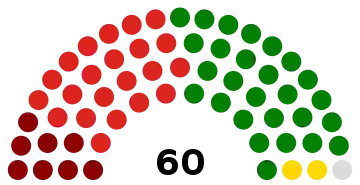Gandaki Provincial Assembly गण्डकी प्रदेश सभा | |
|---|---|
| 2nd Gandaki Provincial Assembly | |
| Type | |
| Type | |
| History | |
| Founded | 2018 |
New session started | 2 January 2023 |
| Leadership | |
Speaker | |
Deputy Speaker | |
Leader of the House (Chief Minister) | |
Leader of Opposition | |
| Structure | |
 | |
Political groups | Government (36)
Opposition (24) |
Length of term | 5 years |
| Elections | |
| Parallel voting: | |
First election | 2017 |
Last election | 20 November 2022 |
Next election | 2027 |
| Meeting place | |
| Town Development Training Centre, Pokhara, Kaski District | |
| Website | |
| pradeshsabha | |
| Constitution | |
| Constitution of Nepal | |
The Provincial Assembly of Gandaki Province also known as the Gandaki Province Sabha, (Nepali: गण्डकी प्रदेश सभा) is a unicameral governing and law making body of Gandaki Province, one of the seven provinces in Nepal. The assembly is seated at the provincial capital Pokhara in Kaski District at the Urban Development Training Centre. The assembly has 60 members of whom 36 are elected through first-past-the-post voting and 24 of whom are elected through proportional representation. The term of the assembly is five years until dissolved earlier.
The present First Provincial Assembly was constituted in 2017, after the 2017 provincial elections. The next election will take place when the five-year term ends by November 2022.
History
The Provincial Assembly of Gandaki Province is formed under Article 175 of the Constitution of Nepal 2015 which guarantees a provincial legislative for each province in the country. The first provincial elections were conducted for all seven provinces in Nepal and the elections in Gandaki Province was conducted for 60 seats to the assembly.[1][2] The first meeting of the provincial assembly was held on 4 February 2018.[3][4] Netra Nath Adhikari from Maoist Centre was elected as the first speaker of the provincial assembly,[5] and Srijana Sharma from CPN (UML) as the first deputy speaker of the provincial assembly.[6]
List of assemblies
| Election Year | Assembly | Start of term | End of term | Speaker | Chief Minister | Party | |
|---|---|---|---|---|---|---|---|
| 2017 | 1st Assembly | 4 February 2018 | September 2022 | Netra Nath Adhikari | Prithvi Subba Gurung (Cabinet) |
CPN (UML) | |
| Krishna Chandra Nepali Pokharel (Cabinet) |
Nepali Congress | ||||||
| 2022 | 2nd Assembly | 2 January 2023 | 27 April 2023 | Krishna Dhital | Khagaraj Adhikari (Cabinet) |
CPN (UML) | |
| 27 April 2023 | Incumbent | Surendra Raj Pandey cabinet (Cabinet) |
Nepali Congress | ||||
Committees
Article 195 of the Constitution of Nepal provides provincial assemblies the power to form special committees in order to manage working procedures.
| S.No. | Committee | Membership |
|---|---|---|
| 1 | Work Arrangement Advisory | 11 |
| 2 | Legislative | 13 |
| 3 | Public Accounts | 13 |
| 4 | Finance and Development | 14 |
| 5 | Provincial Affairs | 11 |
Current composition
| Party | Parliamentary party leader | Seats[7] | |
|---|---|---|---|
| Nepali Congress | Surendra Raj Pandey | 27 | |
| CPN (UML) | Khagaraj Adhikari | 22 | |
| CPN (Maoist Centre) | Hari Bahadur Chuman | 8 | |
| Rastriya Prajatantra Party | 2 | ||
| CPN (Unified Socialist) | 1 | ||
| Total | 60 | ||
See also
References
- ↑ "Prithvi Subba Gurung unanimously elected UML PP leader of Province 4 - The Himalayan Times". The Himalayan Times. 2018-02-11. Retrieved 2018-03-27.
- ↑ "Prithvi Subba Gurung appointed as Province 4 CM - The Himalayan Times". The Himalayan Times. 2018-02-12. Retrieved 2018-03-27.
- ↑ "First Provincial Assembly meeting begins in 4 provinces". kathmandupost.com. Retrieved 2020-12-30.
- ↑ "First provincial assembly meeting of Province 4 begins". The Himalayan Times. 2018-02-05. Retrieved 2020-12-30.
- ↑ "Adhikari unanimously elected Province 4 Speaker". My Republica. Retrieved 2018-03-27.
- ↑ "Srijana Sharma elected as deputy speaker of Province-4". My Republica. Retrieved 2020-12-30.
- ↑ "गण्डकीमा २७ सिटसहित कांग्रेस पहिलो दल, सत्तारुढ गठबन्धनलाई सहज बहुमत". ekantipur.com (in Nepali). Retrieved 2022-12-06.